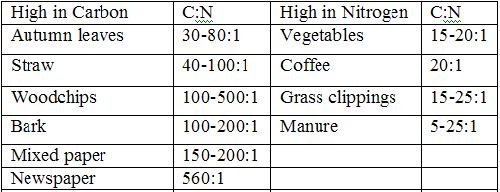In researching the links between chemistry and gardening, composting arose as a key component. While composting merely entails the accumulation of waste outdoors, there is a surprising amount of chemistry involved.
The decomposition of organic materials is rich in nutrients that promote plant growth. When organisms die their stored carbon and nitrogen becomes available to other organisms. Any compost will have a balance between bacteria and plant materials. This is to maintain a healthy carbon to nitrogen ratio. Bacteria typically have a ratio of 4:1, while plant material has 30:1. Carbon and nitrogen are both important elements in plant growth. Carbon is an essential energy source and a building block for plants, as it composes fifty percent of microbial cells. Nitrogen is an important component of proteins, nucleic acids, amino acids, and enzymes. While carbon and nitrogen are both essential, neither is useful independent of the other. Diamonds would be detrimental to a compost heap. The ideal carbon to nitrogen ratio for composting is thirty to one. An excess of nitrogen will cause it to form ammonium gas, toxic to plants, and releasing pungent odors. Conversely, a compost heap deficient in nitrogen will restrict plant growth.
Below is a table of a variety of different plants and their carbon to nitrogen ratios.

No comments:
Post a Comment